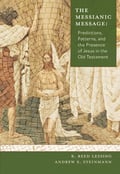The Bible makes it clear that Jesus is the main focus of the New Testament. After all, it was His sacrifice on the cross that saved us. But the importance of Jesus as the Messiah can’t be understood just from the New Testament. The prophecy of a Messiah started in the Old Testament, and that prophecy is key to understanding how Jesus perfectly fulfilled that role.
Recognizing and understanding those connections between the Old and New Testaments is necessary to understand the role that Jesus Christ filled for us. These three principles, developed by Rev. Dr. Reed Lessing and Rev. Dr. Andrew Steinmann in their book The Messianic Message: Predictions, Patterns, and the Presence of Jesus in the Old Testament, will help you get the most out of your study of the Old Testament.
1. Flip Back and Forth
The New Testament (NT) uses words, phrases, and images to demonstrate ways that Jesus fulfills the prophecy of the Savior. The words and imagery in the Old Testament (OT) reveal characteristics of the Messiah that come up in the New Testament. When you encounter these moments, make sure to reference back to those Old Testament passages. Then, you can remember those references and recognize them when they appear over and over again.
NT: All this took place to fulfill what the Lord had spoken by the prophet: “Behold, the virgin shall conceive and bear a son, and they shall call His name Immanuel” (which means, God with us). (Matthew 1:22–23)
OT: Therefore the Lord Himself will give you a sign. Behold, the virgin shall conceive and bear a son, and shall call His name Immanuel. (Isaiah 7:14)
2. Keep Jesus Front of Mind
While there are direct references to the Messiah in the Old Testament, sometimes the message is more subtle. When reading the Old Testament, keep Jesus in the front of your mind and you may notice more connections than you imagined. Events in the Old Testament point to ways that God intended to use the Messiah to save Israel and bring her closer to Him.
OT: And I will pour out on the house of David and the inhabitants of Jerusalem a spirit of grace and pleas for mercy, so that, when they look on Me, on Him whom they have pierced, they shall mourn for Him, as one mourns for an only child, and weep bitterly over Him, as one weeps over a firstborn. (Zechariah 12:10)
NT: But one of the soldiers pierced His side with a spear, and at once there came out blood and water. (John 19:34)
3. Take a New Perspective
Remember that the Old Testament is looking forward to the Messiah, while the New Testament is looking backward at Jesus and His life. When reading the Old Testament, remember what the writers and characters don’t know yet that you do thanks to the context of the New Testament. On the other hand, understand that the New Testament was written after Jesus had lived and died, so it’s a retroactive account. Being aware of these differing perspectives will help you place events and appreciate the connections within the Bible.
Scripture: ESV®.
Blog post adapted from The Messianic Message: Predictions, Patterns, and the Presence of Jesus in the Old Testament, pp. 30, 239–40, © 2023 Andrew E. Steinmann and R. Reed Lessing, published by Concordia Publishing House. All rights reserved.
 For more messianic connections between the Old and New Testaments, check out The Messianic Message.
For more messianic connections between the Old and New Testaments, check out The Messianic Message.
























